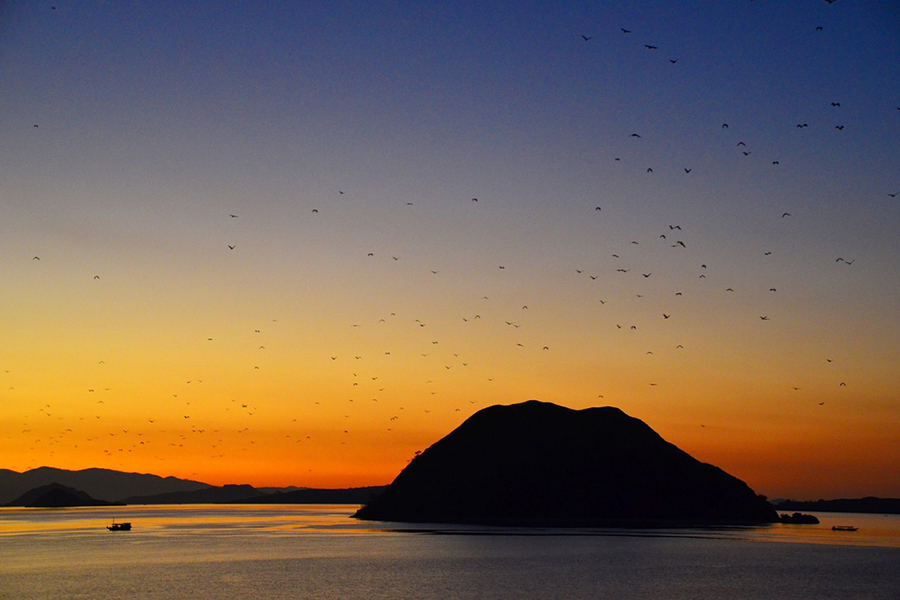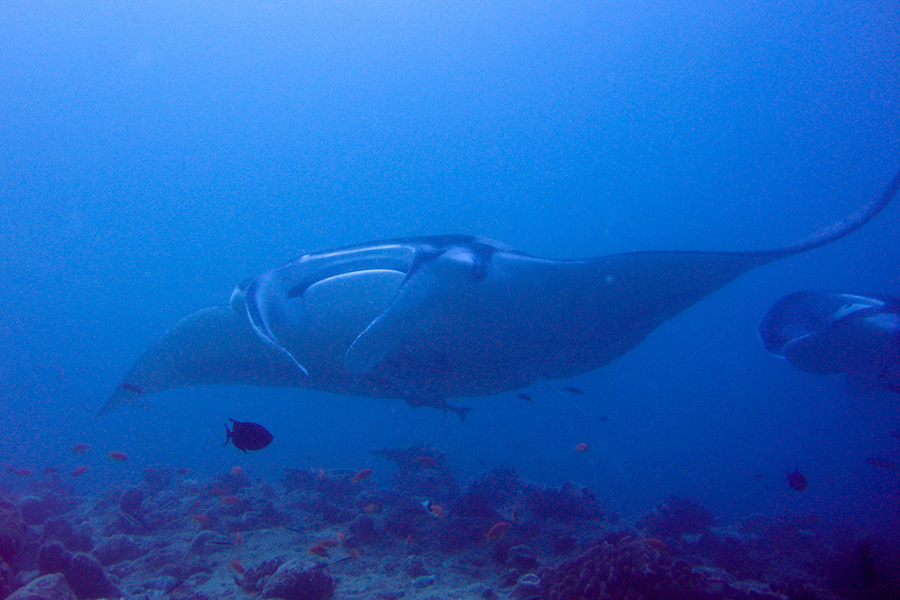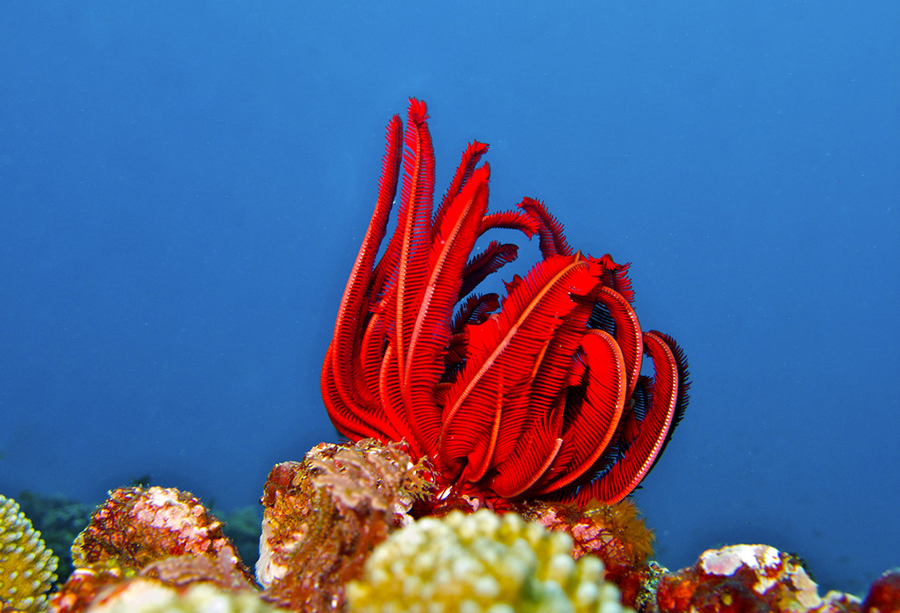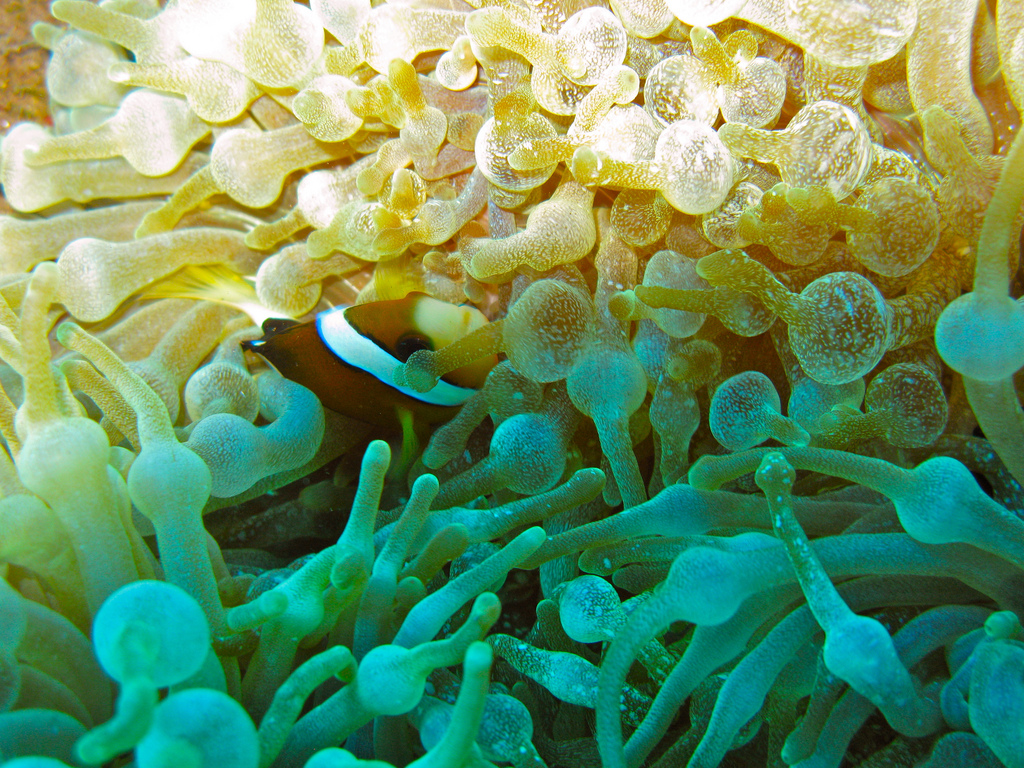Komodo National Park has been officially protected since 1980, but locals have cared for and protected these islands since long before. There are more than one hundred and thirty thousand hectares of protected water in this park so it’s any deep-sea diver’s vision of paradise, but only if you can handle the currents.

Fruit Bats at sunset (Photo: Austronesian Expeditions via Flickr)
Mike, our guide, looked at me and wondered if I was up to it. ‘It’s simple really’ he shouted, trying to work his words through the wind. ‘It’s a drift dive, so if you feel like you might just drift away, just, well, grab onto something. Or someone’.
‘Yeah sure, got it – I’ll be fine!’ I replied, echoing his tone of slightly-wavering confidence. Before I had five seconds to turn over the risks in my mind, it was my turn to jump in. I held my nose and let gravity wrap its arms around me as I was drawn into the sea
Manta Point
I was expecting to drop a few metres down and begin exploring the coral at my own pace. Instead, when I opened my eyes I realized that the boat was no longer above us. The sea wind had picked me up and pulled me far away from where we’d jumped in and so many bubbles were escaping my mouth at once I couldn’t see where I was going. This was a drift dive. Something like an underwater rollercoaster where the currents are the machine and the sea is a slightly unreliable seatbelt.
No longer sure which way was up or down, the only thing stopping me from floating off into the ocean was a hand on my ankle that pulled me back. I turned to see my wide-eyed friend Scarlett pointing towards seven manta rays that were flying above us, blinking out the sun in perfectly spaced intervals. A ‘ninja ray’ (a totally black manta ray) hovered over us for about five seconds. The fish and other divers that crossed its path seemed to disappear into its shadow for a moment.

Manta Ray at a cleaning station (Photo: Chenography via Flickr)
Manta rays are legends of the sea, and it’s easy to see why. To begin with, their four-metre wingspan makes them hard to miss and the slow motion pace that they move in is so measured and effortless that it seems choreographed. They belong to the shark family but there are no jagged teeth in sight as they eat mainly shrimp.
I watched a final one swoop into this ‘cleaning station’, where hundreds of small fish brushed away parasites and dead skin, whilst other smaller ones swam inside its mouth to remove any leftover food. It sat quietly for a few minutes until the job was done and then gracefully floated away on the back of the current. I decided then and there I wanted to be more like a manta ray. The initial fear had subsided and wonder had stepped in to guide me.
Shark Life
I was told the currents would be different in the afternoon, but was warned that there was one at the end of a huge rock nearby that had been known to pull people down to 60m. ‘Stay alert’ the guides said, looking each one of us directly in the eyes to make sure the message had sunk in.
I let the warning drift through my mind in search of something to hold on to. Then it gradually wandered out the other side as we jumped into the water. I was at once distracted and absorbed by what I was seeing. We were alongside a rock the size of a three-story house and it was wild.
This rock, Batu Balong, still has approximately ninety per cent coral cover, meaning that it looks like a child has been given all the art materials, all the time and all the artistic license to decorate it. The intensity of blues and yellows burned the back of my retinas, making LED screens look dull in comparison.

Komodo National Park still maintains a 90% coral cover (Photo: Ilse Reijs and Jan Noud-Hutten via Flickr)
Scarlett called me over to something. She pointed down, beyond where our flippers were keeping us in place, to a long, elegant silhouette. It swayed with the movement of the water, another creature caught up in the current. We heard the signal from Mike. It was a white shark, harmless to us, but a notorious predator of these parts.
The previous day we’d had a session on land about the human impact on shark life. These creatures are hunted for their healing properties and as trophies all over the world. In China and Vietnam, they end up in soup, and in the UK they are seen as wild game, tracked down by guides, who sell shark hunting tours to visitors. On top of this, due to several high profile shark attacks in Australia, there is a possibility that their status as protected creatures might not be upheld. All of these factors leave sharks vulnerable to the destructive potential of untracked human activity in the sea, with the most recent research finding that out of over four hundred species of shark, at least one hundred are endangered. Many divers will say that the hyped up media reputation of these creatures hasn’t helped the species either.
‘Jaws basically ruined it for sharks worldwide’, said Mike, as he gazed out to sea.
We hovered perfectly still above the white shark until gradually, it woke, waved goodbye to us with its tail and cut through the water into further depths of the ocean. Scarlett had been trying to tell me for years that sharks were misunderstood, and now I got it.
Swept Up
Further around the rock we met lilac crocodile fish who were lounging on orange coral and spotted moray eels poking their heads out of swelled up blue lily pads with candy floss flowers. Praying mantis shrimp raised their heads in slow motion – their huge, bespectacled eyes pondering over our strange tails – and the cuttlefish performed their dance in tandem to the rest of the reef.
Scarlett had swum out, away from the rock and seeing her do a backflip pulled me out of my imagination. Suddenly I noticed that my attempts at swimming were no longer helping me to move. Looking around I stopped focusing on the sea life; realising that I was slowly drifting towards the end of the rock where we had been warned not to go. I was now fighting a current, and in a state of wonder combined with panic I’d forgotten how to swim. Instead, I froze. Debbie, my guide had clocked it before I had and so was by my side instantly. A firm hand on my arm and some signals to kick hard and we gradually pulled out of it.

Clown fish hiding in the coral (Photo: Liam Clancy via Flickr)
My tank had run out of air twice as quickly as it should have due to my panicked breathing. Urgency minus gravity was confusing. With nothing to hold on to, and without anything holding onto me, I had relied on my breath, my most immediate connection to life on land. My body felt weak and unsettled, rattled and soaked and as soon as we hit the deck I threw off my mask and took a long deep breath in through my nose. Breathing. I’d never realized how much I’d taken it for granted and how vulnerable I’d feel without it. I felt embarrassed for how invincible I’d felt underwater and was reminded the hard way that I was an uninvited visitor.
Exhale
The afternoon took a more relaxed turn. Debbie, my guide, decided it was time to show us something weird. We jumped into some water around rocks that had caves as pockets. Sending minimal motion through our ankles to keep us afloat and moving as slowly as we could, we entered one of the bigger caves in a whisper. Debbie flicked her torch on so we didn’t collide with any of the residents and pointed to an inlay, signalling for me to look closely. Swinging off the edge of the rock was something bizarre. A nudibranch. It resembled a slug which had experienced an unfortunate accident with an orange highlighter and as a result was so glow-in-the-dark that it had no choice but to flaunt it. Up the length of this creature were deep purple and bright yellow spots and as we moved through the cave more and more of these strange slimy forms of life revealed themselves to us. They were adorned in shades of red, green, mustard yellow and black and shimmying through the coral without a care. I wanted to reach out to touch so much of what I was seeing, but knew that every fingerprint left on the reef is a scar marked permanently on its skin.

Unusual creatures of the deep (Photo: Liam Clancy via Flickr)
Listening In
Forty minutes later, our tanks began to run out of air so we followed the bubbles to the surface. Back on the boat we star-fished out and headed back through the National Park to land, passing other boats heading home after a long day in the waves and watching birds skit above the water in search of fish. By the time we touched back onto the sand, the sun was beginning to graze along the spines of the islands, these ancient rock formations that with a glance could have been mistaken for sleeping dinosaurs.
‘Look – the bats’, Mike whispered as we were tip toeing up the beach.
A group of about eighty bats were floating across the wind from the West to the East, perforating a line through the horizon. We were all motionless, whipped up in a tide of wonder as we surrendered our attention to the moment. It was the perfect end to a day of getting caught up in, absorbed by and firmly told off by the Earth, and I began to realise that if I could only listen and notice more, I would maybe hear what it was calling for.